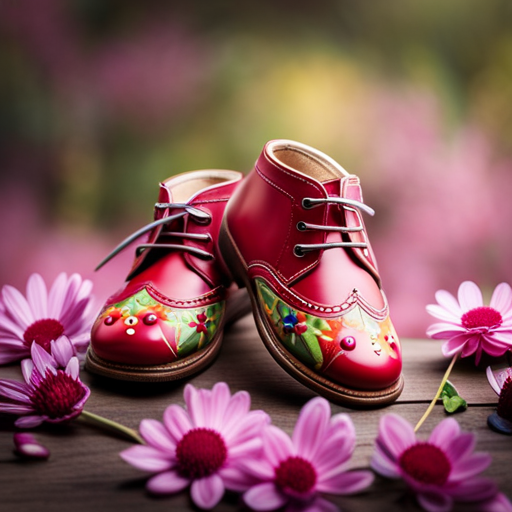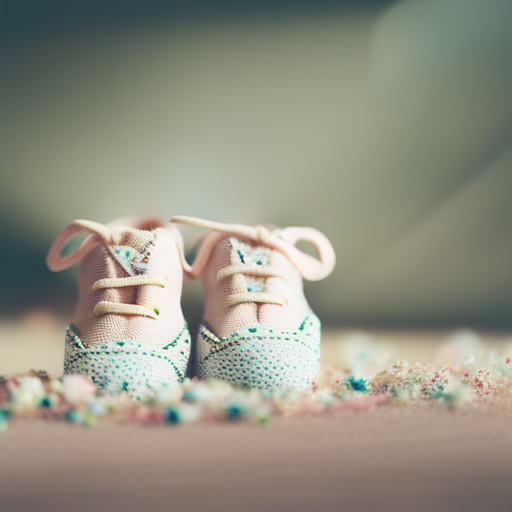How to Buy Baby Shoes
Did you know that babies’ feet have 26 bones, 33 joints, and over 100 muscles, tendons, and ligaments?
With their delicate and rapidly growing feet, it is crucial to provide them with proper footwear.
In this article, we will guide you through the process of buying baby shoes, from understanding the importance of footwear to choosing the right size and style.
Stay tuned to discover tips for trying on and caring for baby shoes, as well as budget-friendly options and where to purchase them.
Key Takeaways
- Proper footwear is crucial for babies’ overall development and comfort.
- Accurately measure the length and width of your baby’s feet when determining the shoe size.
- Choose shoes made from breathable materials with flexible soles and non-slip soles.
- Consider factors such as size, material, flexibility, and closure when selecting baby shoes.
Understanding the Importance of Proper Footwear for Babies
The importance of proper footwear for babies cannot be overstated, as it plays a crucial role in their overall development and comfort. When it comes to choosing the right material for baby shoes, there are a few factors to consider.
First and foremost, it is important to select shoes made from breathable materials, such as soft leather or mesh fabric, to ensure proper air circulation and prevent sweating or discomfort.
Another key consideration is the flexibility of the soles. Babies’ feet are soft and pliable, and their shoes should reflect this. Opting for shoes with flexible soles allows for natural movement and development of the foot muscles. This is especially important as babies start to take their first steps, as it helps them maintain their balance and develop their walking skills.
In addition to these benefits, flexible soles also provide a better grip on various surfaces, reducing the risk of slips and falls. It is important to choose shoes with non-slip soles to ensure the safety of the baby while crawling or walking.
Determining the Right Shoe Size for Your Baby
Measuring the length and width of your baby’s feet accurately, as well as considering their growth rate, is crucial in determining the right shoe size for your baby, ensuring a comfortable fit and proper foot development. Many parents rely on shoe size charts or guesswork when buying shoes for their babies, but these methods can lead to common misconceptions and ill-fitting shoes.
To measure your baby’s feet accurately, start by placing their foot on a piece of paper and tracing around it. Measure the length from the heel to the longest toe and the width at the widest point. Take these measurements with you when shopping for shoes and refer to the size guide provided by the manufacturer.
It’s important to note that babies’ feet grow rapidly in the first few years of life. Therefore, it’s recommended to measure their feet every few months to ensure they are wearing the correct size. Ill-fitting shoes can hinder proper foot development and cause discomfort for your baby.
Another common misconception is that buying shoes that are too big will allow room for growth. However, this can lead to tripping and discomfort. It’s best to choose shoes that have about a thumb’s width of space between the longest toe and the front of the shoe.
Types of Baby Shoes: Which Ones Are Best
When considering the best types of baby shoes, it is important to evaluate the various options available and determine which ones provide the optimal combination of support, flexibility, and comfort for your growing child’s feet. Baby shoe materials play a crucial role in achieving these qualities. Some popular materials used for baby shoes include leather, canvas, and synthetic materials.
Leather shoes are a popular choice due to their durability and breathability. They provide excellent support and flexibility, allowing your baby’s feet to develop properly. However, leather shoes can be expensive and may require more maintenance.
Canvas shoes are lightweight and breathable, making them ideal for warmer weather. They are also more affordable compared to leather shoes. However, they may not provide as much support as leather shoes.
Synthetic materials, such as rubber or foam, are often used in baby shoes for their cushioning and shock-absorbing properties. These materials are usually more affordable and easy to clean. However, they may not offer the same level of breathability as leather or canvas shoes.
When it comes to popular baby shoe brands, there are several options to choose from. Some well-known brands include Nike, Adidas, Stride Rite, and Robeez. These brands often prioritize quality and comfort, ensuring that your baby’s feet are well-supported.
Factors to Consider When Selecting Baby Shoes
One important factor to consider when selecting baby shoes is the overall fit, as an ill-fitting shoe can hinder proper foot development. To ensure the best fit for your baby, here are four factors to consider when choosing baby shoes:
Size: Baby shoes should be chosen based on the length and width of their feet. It is important to measure their feet regularly, as their size can change rapidly during the early years. Shoes that are too tight can cause discomfort and restrict natural foot movement, while shoes that are too loose can lead to tripping and falls.
Material: Choosing the right material is crucial for baby shoes. Soft, breathable materials like leather or cloth allow for proper ventilation and reduce the risk of developing foot problems such as blisters or fungal infections. Avoid shoes made from synthetic materials that can trap moisture and heat, as this can lead to discomfort and skin irritation.
Flexibility: Baby shoes should be flexible to allow natural movement and growth of their feet. Look for shoes with soft soles that can bend easily and provide adequate support. Stiff or rigid shoes can restrict foot movement and hinder proper development.
Closure: Opt for shoes with adjustable closures like Velcro or laces. This allows for a customized fit and makes it easier to put on and take off the shoes. Avoid shoes with hard closures like buckles or snaps, as they can be uncomfortable and difficult to manage for both the baby and the caregiver.
Considering these factors will help you make an informed decision when selecting baby shoes, ensuring the best fit and comfort for your little one’s growing feet.
Tips for Trying on and Testing Baby Shoes
As you try on and test baby shoes, it is important to pay attention to the fit, flexibility, and comfort, so that you can choose the best pair for your little one’s growing feet.
Trying on shoes is not only about finding the right size but also ensuring that the shoe provides the necessary support and flexibility for your baby’s developing feet.
When trying on shoes, start by measuring your baby’s feet to determine the correct size. Remember that baby’s feet grow rapidly, so it is advisable to measure them frequently. As you try on different pairs, make sure there is enough room for the toes to wiggle and that the shoe doesn’t squeeze or pinch their feet.
Next, focus on the shoe’s flexibility. Babies’ feet are still developing, and they need shoes that allow for natural movement. Look for shoes with soft soles that bend easily, allowing your baby’s feet to flex and move without restrictions.
Comfort is paramount when choosing baby shoes. Look for shoes with cushioned insoles and padded collars to provide extra comfort and support. Choose materials that are breathable and avoid shoes with rough seams or hard edges that may irritate your baby’s delicate skin.
How to Choose Baby Shoes for Different Occasions
To ensure your baby is comfortable and stylish for every occasion, carefully consider the fit, flexibility, and support of their shoes, allowing them to move with ease and confidence. When choosing footwear for different weather conditions, it is important to prioritize both functionality and style. Here are four key factors to consider:
Weather-appropriate materials: Opt for shoes made from breathable fabrics like mesh or canvas for warmer weather, allowing your baby’s feet to stay cool and dry. For colder temperatures, choose shoes with insulated linings and water-resistant materials to keep their feet warm and protected.
Non-slip soles: Look for shoes with non-slip soles to ensure stability and prevent accidents, especially when walking on wet or slippery surfaces. Rubber or textured soles provide better traction and grip, promoting a confident stride.
Flexible and lightweight construction: Babies’ feet are still developing, so it is crucial to choose shoes that allow natural movement. Look for flexible and lightweight designs that mimic barefoot walking, allowing the feet to develop strength and coordination.
Proper arch and ankle support: The importance of proper shoe support for baby’s foot development cannot be overstated. Look for shoes with cushioned insoles, arch support, and secure ankle closures to ensure proper alignment and reduce the risk of foot problems later in life.
Finding the Perfect Balance Between Style and Functionality
In order to achieve the perfect balance between style and functionality, it is important to prioritize both aesthetics and practicality when selecting footwear for your baby.
Style trends come and go, but durability and safety should always remain top priorities. When it comes to baby shoes, it is crucial to choose ones that not only look good but also provide the necessary support and protection for your little one’s developing feet.
When considering style trends, it is essential to remember that babies’ feet are still growing and developing. Opting for shoes that are too restrictive or have excessive padding can hinder their natural foot development. Instead, look for shoes that have flexible soles and provide ample room for their toes to move freely. This will promote healthy foot development and ensure their comfort.
Additionally, durability is key when selecting baby shoes. Babies are constantly on the move, so it is important to invest in shoes made from high-quality materials that can withstand their active lifestyles. Look for shoes with reinforced stitching and sturdy soles that can withstand wear and tear.
Last but not least, safety should always be a top concern. Choose shoes that have non-slip soles to prevent accidents and falls. Also, ensure that the shoes fit properly and do not cause any discomfort or restrict movement.
Caring for and Maintaining Baby Shoes
Proper care and regular maintenance are essential for preserving the quality and longevity of baby shoes, ensuring their durability and protecting your little one’s feet.
Here are four important steps to consider when caring for baby shoes and preventing foot problems in babies:
Cleanliness: Regularly clean baby shoes to remove dirt and debris. Use a soft cloth or brush to gently wipe away any dirt, and avoid using harsh chemicals that may damage the material. It is also important to let the shoes dry completely before storing them.
Storage: Proper storage is vital to maintaining the shape and condition of baby shoes. Avoid piling them up or placing heavy objects on top of them, as this can cause deformation. Instead, store them in a cool, dry place, and consider using a shoe organizer or individual shoe boxes to keep them organized and protected.
Size and Fit: Ensure that baby shoes are the correct size and fit for your little one’s feet. Ill-fitting shoes can cause discomfort, blisters, and even foot problems. Regularly check the size and fit as your baby’s feet grow, and replace shoes that no longer fit properly.
Quality Material: Invest in high-quality baby shoes made from breathable and flexible materials. This will not only provide comfort for your baby but also prevent foot problems such as excessive sweating or irritation.
Where to Buy Baby Shoes: Online Vs. In-Store
The convenience of online shopping allows parents to compare prices, styles, and reviews, making it easier to find the perfect pair of baby shoes. However, when it comes to buying baby shoes, there are pros and cons to consider for both online and in-store purchases.
One of the benefits of shopping for baby shoes in person is the ability to try them on. This ensures a proper fit and eliminates the need for returns or exchanges. In-store shopping also allows parents to see and feel the quality of the shoes before making a purchase. Additionally, it provides an opportunity to receive personalized assistance from knowledgeable staff who can offer advice on sizing and style.
On the other hand, online shopping offers a wider variety of options, often at more competitive prices. It allows parents to compare different brands and styles without the hassle of going from store to store. Online reviews can also provide valuable insights from other parents who have purchased the same shoes.
Ultimately, the decision between buying baby shoes online or in-store depends on personal preferences and priorities. For those who prioritize convenience and a larger selection, online shopping may be the preferred option. However, for those who value personalized assistance and the ability to try on shoes before purchasing, visiting a physical store may be the better choice.
Budget-Friendly Options for Baby Shoes
There are several affordable and practical options available for parents looking for budget-friendly baby shoes, including discounted sales and second-hand options. When it comes to buying baby shoes, it is important to find options that not only fit the budget but also provide comfort and support for the little one’s growing feet.
Here are four options to consider:
Discounted sales: Many retailers offer periodic sales and promotions, which can significantly reduce the cost of baby shoes. Keep an eye out for these sales and take advantage of the discounted prices to get quality shoes at a fraction of the original price.
Online marketplaces: Online platforms like eBay and Facebook Marketplace often have listings for gently used baby shoes at affordable prices. Buying second-hand shoes can be a cost-effective option, especially considering how quickly babies outgrow their footwear.
Consignment stores: Consignment stores specialize in selling gently used items, including baby shoes. These stores carefully curate their inventory, ensuring that the shoes are in good condition and meet safety standards. This can be a great option for finding well-priced, quality shoes.
Local parenting groups: Online communities and local parenting groups often have buy/sell/trade sections where parents can find affordable baby items, including shoes. These groups provide a platform for connecting with other parents who may be looking to sell their baby shoes at a reasonable price.
Frequently Asked Questions
Are There Any Specific Shoe Brands That Are Recommended for Babies?
When it comes to baby shoe sizes, it is important to choose brands that prioritize comfort, support, and proper development. Some popular baby shoe brands known for their quality and fit include [brand names].
How Often Should I Measure My Baby’s Feet to Ensure the Right Shoe Size?
To ensure the right shoe size for your baby, it is important to measure their feet regularly. Start buying shoes when they begin walking. Measure their feet by placing them on a piece of paper and tracing around them.
Are There Any Specific Factors to Consider When Selecting Shoes for Babies With Wide Feet?
When selecting shoes for babies with wide feet, it is important to consider factors such as the flexibility of the shoe, the width of the shoe, and the materials used. Barefoot walking and shoe materials play a crucial role in providing comfort and support.
Can I Use Hand-Me-Down Shoes for My Baby?
Hand-me-down shoes may seem cost-effective, but they can potentially affect your baby’s foot development and cause discomfort. It is important to prioritize your baby’s comfort and foot health by investing in properly fitting and supportive shoes.
What Are the Signs That Indicate My Baby Needs a New Pair of Shoes?
Signs of shoe discomfort in babies include redness, blisters, and difficulty walking. It is crucial to ensure proper shoe fit to support their growing feet. Regularly checking for these signs and replacing shoes as needed is essential for their comfort and development.
Conclusion
In conclusion, proper footwear for babies is essential for their foot development and overall comfort. By determining the right shoe size and considering factors such as material and flexibility, parents can ensure they are selecting the best shoes for their little ones.
Additionally, finding a balance between style and functionality can make the shoe buying process more enjoyable. Whether purchasing online or in-store, there are budget-friendly options available for every budget.
Remember to care for and maintain baby shoes to prolong their lifespan and keep them looking their best.








